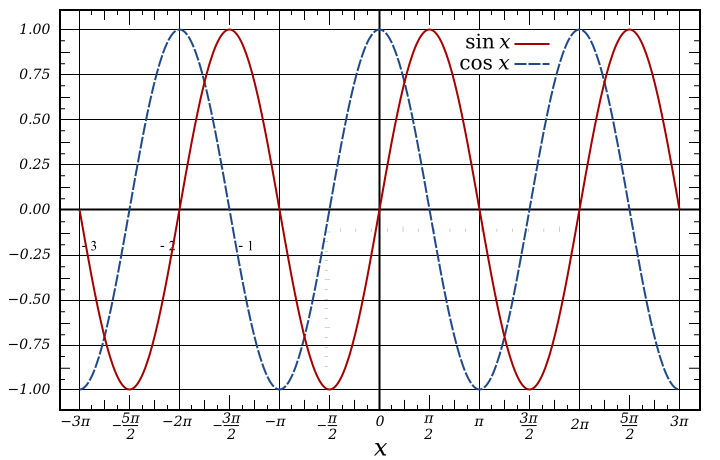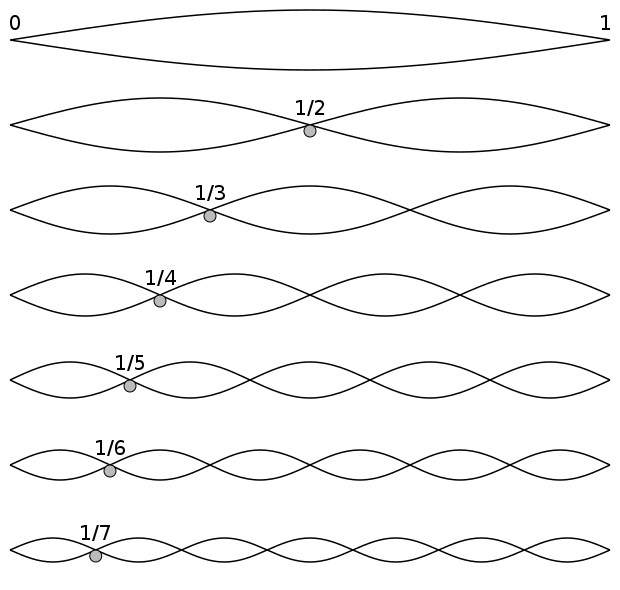We now know that a sound wave is made up of moments of
compression and
rarefaction, and we know a little bit about a
waveform as well. But there are other parts to a wave that we need to know about before we get into just what resonance really is. Those parts are:
Period,
frequency,
amplitude,
phase, and
wavelength.
No doubt, you've heard of some of these before. Frequency and amplitude, in particular, get a lot of attention in the music world. A lot of times, we talk about frequency and amplitude as synonymous with pitch and loudness, and for most purposes they are. However, when I talk about frequency and amplitude, I'm going to be referring to the actual
physical properties of the sound wave (or waves), meaning the parts of the wave that can be measured with proper instrumentation and then studied. Therefore, frequency and amplitude are
objective measurements. Pitch and loudness are usually associated with the
perceptual properties of the wave, i.e. just how loud or how high/low a person
perceives that sound differs from person to person (and from ear to ear, for that matter); so pitch and loudness cannot be measured
per se, but rather discussed
subjectively. (And remember from my
previous post: Anytime I'm talking about
perception, I'm talking about the interaction from a sensory signal with a person's higher cognitive functions and life experiences. Therefore, perception is
always subjective.)
 |
| Yup, those are the same sine and cosine functions from trigonometry that you see on your calculator. |
When you look at the waveform of a basic
sine wave (the red line) shown above, you'll see that it has a repeating pattern. The number of repeats of this pattern in a given amount of time is called the frequency of the wave. This is usually given in Hertz, but can also be stated as the number of cycles per second of the wave pattern. (See, it was originally called cycles per second (cps), but then the International Electrotechnical Commission (IEC) decided to honor
Heinrich Hertz's contribution to the field of electromagnetism, so they gave him a unit of measurement, cps, and called it Hertz (Hz). Scientists are always re-naming units to honor the great contributors to the field. Sorta like how medical terminology is also littered with the names of big anatomy contributors, etc.) So, for the famous A440 that orchestra's (supposedly) tune to, the frequency is 440 cycles per second, or 440 Hz. In math terms, frequency is shown by: frequency = velocity over wavelength (f = v/
λ). Sounds pretty fancy, but the reason I'm putting this here is because the period of a wave is related to the frequency. The period is how long it takes for one cycle of the wave pattern to complete itself. So if the frequency could be shown as: 1/period, then the period is shown by: 1/frequency. Seems like we're talking about the same thing, but in general, the frequency refers to how often the wave pattern is repeating itself where the period refers to how long it takes for one pattern of the wave to complete itself. Why do we bother with this distinction? Well, because it comes in really handy for mathematical analysis of wave patterns. Why should singers bother to know about this? Because...well...I'll get there for ya. (Besides, if your ever playing around with PRAAT or some other spectrograph software, you'll probably see options for period or frequency change, and you might want to know what you're changing out as you play around.)
Wavelength corresponds to the distance one cycle of the wave travels. Slower frequencies have longer wavelengths, so one cycle of A440 travels double the distance through the atmosphere than A880. (In the above equations, wavelength is represented by that funny-looking symbol, which turns out to be the Greek letter lambda. So now, when you poke around wikipedia and see frequency equations, you'll know some of what you're looking at.)
The amplitude of a wave corresponds to it's perceptual loudness, and is related to the amount of displacement the air particles go through in the sound wave. Because it has to do with how far each particle is being "pushed," amplitude represents the
atmospheric pressure of a sound wave, and is measured in
decibels (dB). In the waveform shown above, amplitude is represented on the vertical axis. So if the sine wave had a higher amplitude, it would have taller peeks and lower valleys, going past the 1.00 marked above. Even though amplitude of sound is represented by this vertical displacement on the waveform, in longitudinal waves, the displacement in the real world is happening horizontally. This is different for other wave types, like light, but the math and the graphical representations are the same. (I just want to point that out because it's easy to misinterpret the sound waves from your mouth as looking just like the waveform representation, but if we could see the sound wave, it would like more like the animation
here. That's kinda important to remember once we get to the anatomy of the ear and the role the ear drum plays in hearing. And, oh yeah! I'm going to get into the anatomy of the ear and how it plays a role in resonance as well, for both the audience and the singer!)
Phase is where we start to get into some important stuff when it comes to understanding resonance, and especially the phenomenon of standing waves. The phase of the sine wave in the above picture basically is where in the cycle the wave starts when you're looking at the vertical axis. Let's look at it more closely:
See how the sine wave is passing through the vertical axis where the horizontal line equals 0? Now look at the cosine wave (blue, dotted line). Cosine is passing through that vertical axis where a horizontal line equals 1. So the phase of the sine wave is not the same as the phase of the cosine wave. The fancy way of saying that is that cosine has a different phase shift than sine. In fact, that's actually the main difference between sine and cosine: The phase shift between the two.
Phase is really, really important because if you have two sound waves that are out-of-shift like this:
 |
| Look at the three middle waves to see the phase difference. |
You'll see how when one wave has a peek in its amplitude, the other wave has a valley, or a negative amplitude. This means that when one wave is in it's period of compression, the other is in rarefaction. The result is that these two waves actually cancel each other out, because if the atmospheric pressure is equally positive in one wave while the pressure is equally negative from the other wave, the two pressure differences cancel each other out. 1-1=0, right? Crazy, huh?
But what happens when two sound waves are perfectly in phase? What if you've got 1 + 1 instead of 1 -1? That's where the phenomenon of standing waves comes in, and that's what we'll start up with next time. Stay tuned!
Raphel, L. J., Borden, G. J., Harris, K. S. (2007). Speech science primer: Physiology, acoustics, perception of speech (5th ed.). Philadelphia, PA: Lippincott Williams & Williams.





